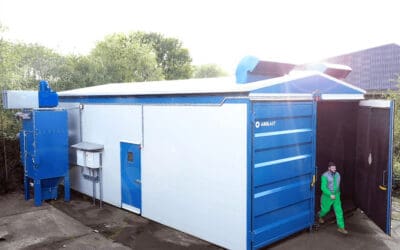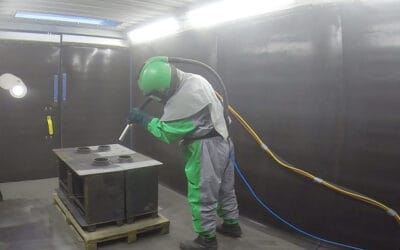Blast Rooms vs. Blast Cabinets: Which Is Right for Your Business?
Surface preparation and finishing are critical in many industries, from automotive to aerospace. Choosing the right equipment for media blasting is essential to ensure efficiency, cost-effectiveness, and optimal results.
Two of the most common options for surface blasting are blast rooms and blast cabinets. Both have unique advantages, and selecting the right one depends on the size of your operation, the materials you work with, and the scope of your projects.
At Airblast AFC, we specialize in the design, manufacture, and installation of blast rooms, spray booths, and equipment tailored to your surface preparation needs. In this guide, we’ll explore the key differences between blast rooms and blast cabinets, the applications they are best suited for, and how to determine which one is the right choice for your business.
What is a Blast Room?
A blast room is a large, enclosed space designed to handle heavy duty, industrial-scale blasting operations. This fully enclosed environment allows operators to use a variety of abrasive media, such as steel grit, aluminum oxide, and silicon carbide, to clean, prepare, or finish large parts, or even vehicles.
Key Features of Blast Rooms:
- Large Space: A blast room is typically spacious enough to accommodate big, bulky items such as machinery, vehicles, or large metal parts.
- Customizable: These rooms can be customized to meet specific business needs, including ventilation, media recovery systems, and lighting.
- Full Operator Control: Workers inside the blast room manually handle the blasting process, providing precision and flexibility for various tasks.
- Media Recycling: Many blast rooms include abrasive media recovery systems that collect and recycle blast media, reducing waste and operating costs.
Applications:
- Heavy Duty Equipment: Industries that deal with large-scale or oversized components, such as shipping, automotive, and aerospace, benefit from blast rooms.
- Customization and Flexibility: A blast room offers flexibility for diverse jobs, from cleaning and prepping industrial parts to refurbishing heavy equipment or vehicles.
- Industrial-Scale Blasting: These systems are built for continuous, large-scale operations that require a controlled environment.
What is a Blast Cabinet?
A blast cabinet is a smaller, enclosed system where the operator inserts their hands into gloves built into the cabinet, manipulating a nozzle to direct abrasive media onto smaller parts. Blast cabinets are designed for precision work and are often used in industries where small to medium-sized components require surface preparation or finishing.
Key Features of Blast Cabinets:
- Compact and Space-Saving: Unlike blast rooms, blast cabinets take up far less space, making them ideal for smaller operations or workshops.
- Operator Protection: Blast cabinets provide a sealed environment that protects the operator from dust, noise, and hazardous materials.
- Efficient for Small-Scale Work: They are optimized for handling smaller, delicate items, such as metal tools, parts, and assemblies.
- Cost-Effective: These systems require less infrastructure, which makes them more affordable for smaller businesses or those with limited space.
Applications:
- Small Parts and Precision Work: Ideal for industries that deal with smaller components like automotive restoration, jewelry, and small metal fabrication.
- Batch Work: Perfect for operations where small parts need to be processed in batches, providing efficiency in completing repetitive tasks.
- Maintenance and Repair: Blast cabinets are widely used for cleaning and surface preparation of smaller parts, such as engine components or tools.
Comparing Blast Rooms and Blast Cabinets
1. Size and Capacity
- Blast Rooms: These systems are designed for large items and can handle high-volume or oversized workpieces. They are perfect for companies that need to blast large equipment or multiple large items simultaneously.
- Blast Cabinets: Compact and better suited for smaller-scale projects, blast cabinets work well when handling small parts or components that need precision cleaning or surface treatment.
2. Type of Operation
- Blast Rooms: Operators work inside the room, wearing personal protective equipment (PPE), and use hand-held blast nozzles to manually control the blasting process. This level of control is crucial for jobs that require intricate attention to detail on large or complex surfaces.
- Blast Cabinets: Operators control the blasting process from the outside, using gloves to manipulate the parts inside the cabinet. This setup is safer and more efficient for handling small to medium-sized objects.
3. Media Recovery Systems
- Blast Rooms: Often come equipped with sophisticated abrasive media recovery systems. These systems can collect and reuse blast media, significantly reducing operational costs, especially in industrial-scale settings where large quantities of media are used.
- Blast Cabinets: Also feature media recovery, but on a smaller scale. The media used in blast cabinets is often recycled through built-in filtration systems, ensuring minimal waste and consistent performance over time.
4. Cost and Infrastructure
- Blast Rooms: Due to their size, customizability, and advanced features, blast rooms represent a significant upfront investment. However, for businesses that require industrial-scale blasting, the long-term savings and efficiency make them worth the cost. These systems also require substantial space and infrastructure, such as ventilation and dust collection systems.
- Blast Cabinets: More affordable and easier to install, blast cabinets are the go-to option for smaller businesses or workshops with limited space. They require less infrastructure and are often more energy-efficient, making them ideal for operations on a tighter budget.
5. Safety and Environmental Considerations
- Blast Rooms: Workers inside blast rooms must wear PPE, including respirators and protective suits, to avoid exposure to dust, noise, and abrasive particles. Proper ventilation and dust collection systems are critical to ensure safety and regulatory compliance.
- Blast Cabinets: Blast cabinets offer a sealed environment, making them much safer for operators. They contain dust and debris within the cabinet, minimizing exposure to hazardous materials and reducing the need for complex ventilation systems.
Which Option is Right for Your Business?
Deciding between a blast room and a blast cabinet depends on several factors, including the size of your operation, the materials you work with, and your budget. Here are some considerations to help you choose:
Choose a Blast Room If…
- You need to blast large, bulky items such as vehicles, industrial equipment, or heavy machinery.
- Your business requires industrial-scale blasting with high production volume.
- You have the space and budget to invest in a larger, customized system.
- You value long-term savings through media recycling and reduced labor costs.
Choose a Blast Cabinet If…
- You work with smaller components or need precision blasting for delicate parts.
- Space is limited, and you need a compact, efficient system.
- You have a smaller budget and are looking for a cost-effective solution.
- You require minimal infrastructure and want a system that is easy to install and operate.
At Airblast AFC, we offer a range of blasting solutions designed to meet the diverse needs of various industries. Our blast rooms are fully customizable, allowing businesses to create the perfect environment for large-scale blasting operations.
Whether you need a large-scale blast room or a more compact blast cabinet, we can help you find the right solution. With decades of experience in the industry, we ensure that our systems are built to the highest standards of safety, performance, and cost-effectiveness.
Contact us today to learn more about how we can help your business thrive.

